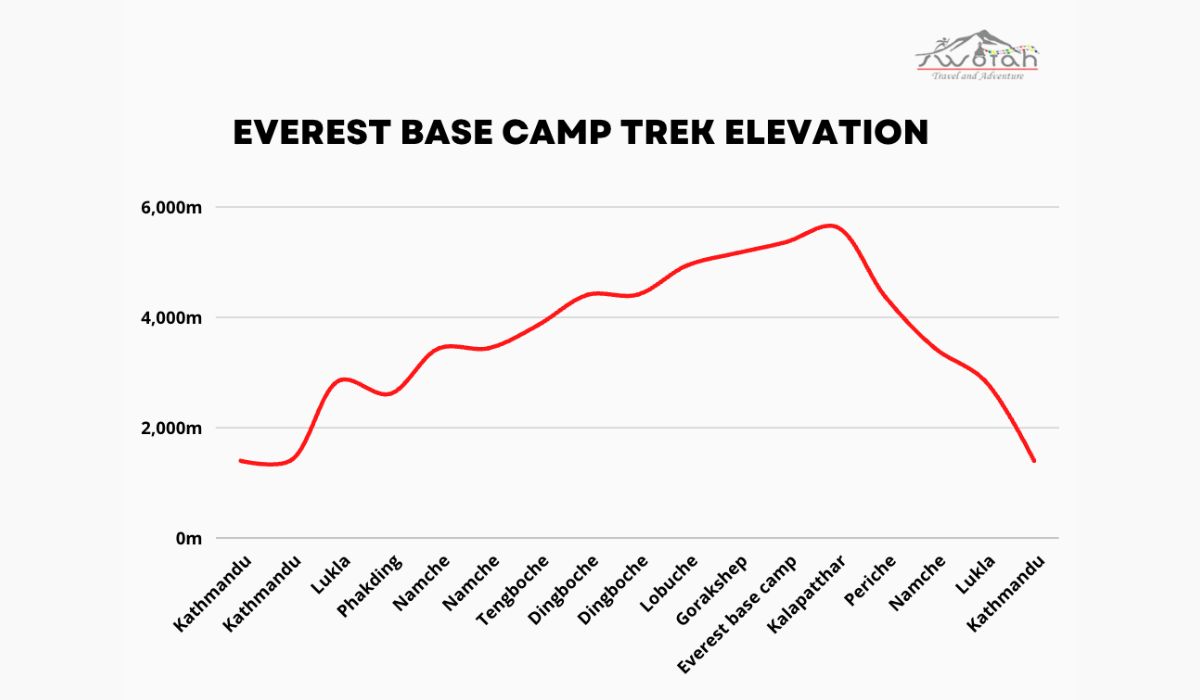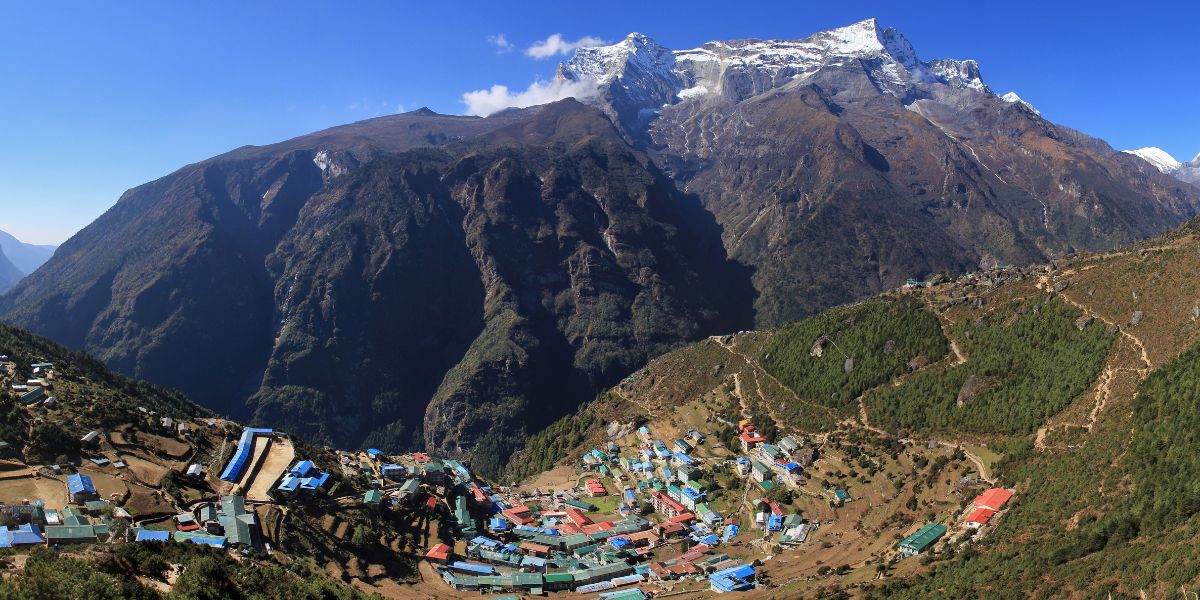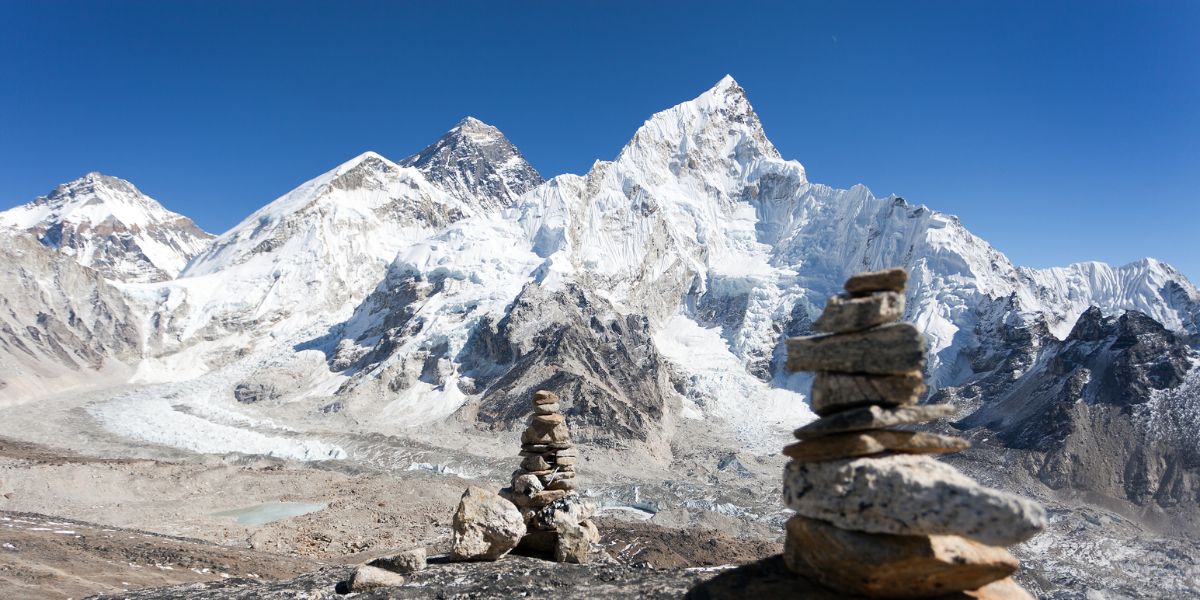
Everest Base Camp Elevation

Everest Base Camp Elevation
swotah travel
7406
03, 02 2023
When it comes to travel and trekking, Nepal is the foremost country name that comes to everyone's mind. Being a mountainous country, Nepal offers a variety of scopes in the tourism field that comes in the form of trekking, paragliding, mountain climbing, rafting, and many others.
If we talk about trekking, one of the unmatchable trekking destinations is Everest Base Camp - it is everyone's dream destination.
You might have heard or read blogs about the Everest Base Camp trek in Nepal, and that might have sounded like a really satisfying story. But have you ever considered trekking to this amazing place yourself?
If so, then this blog post is for you. We have discussed the exploration of Everest Base Camp Elevation. Along with that, we'll discuss what it takes to get there and some of the risks associated with attempting such a feat. So, if you're itching for adventure, read on and let the journey begin!
Geographical Facts About Everest Base Camp
Everest Base Camp is located in the Solu-Khumbu district of Nepal. It is situated at 28°0′26″N latitude and 86°51′34″E longitude.
Everest Base Camp sits at an altitude of 5,364 meters (17,598 feet) in the Khumbu region of Nepal. One of the nearest natural perks around the base camp is Khumbu Glacier, which is at an altitude of 4,900 meters (16,100 feet).
Throughout the years, Everest Base Camp has been a key destination for thousands of tourists. The first mountaineers to summit Mount Everest, Sir Edmund Hillary and Tenzing Norgay Sherpa, also visited the Base Camp during their Everest Expedition in 1953. Since then, it has been the junction of climbers as they attempt to reach the top of the world's tallest mountain.
The highest point of Everest Base Camp is Kala Patthar - which means that the journey of EBC Trek is more limited than other forms of trekking in this region. Unlike the hiking package of Everest Three Passes, where you visit three passes over 5000 meters, your last stop will be Kala Patthar. But it does not mean you have to stop engaging in extra activities - there's always a place for extra things during trekking.
The journey to Everest Base Camp is not easy, and it typically takes around two weeks to reach the camp from Kathmandu. However, the rewards are more than worth it, as climbers experience some of the most beautiful scenery on Earth while also testing their limits.
What Is the Elevation of Everest Base Camp?
There are two base camps for Everest: South And North Base Camps. The South Base Camp of Everest is in Nepal, while the North remains in Tibet.
The elevation of South Everest Base Camp is 5.364 meters, which is 17,598 feet above sea level. Similarly, the North Everest Base Camp sits at an altitude of 5,515 meters in Tibet.
Both Everest Base Camps are the starting point for most expeditions to Mount Everest. Similarly, it has been a home base for many of the support staff who work on the mountain, especially the Sherpa community.
Altitude is the primary reason it is one of the most difficult places to live and work. People not used to the altitude are likely to experience illnesses like altitude sickness. Even with acclimatization, it is still a challenging place to be.
Elevation Table
|
S.N. |
Places |
Elevation |
|
01 |
Kathmandu |
1,300m/ 4265.092 ft |
|
02 |
Lukla |
2,800m/ 9186.352 ft |
|
03 |
Phakding |
2,640m/ 8661.417 ft |
|
04 |
Namche Bazaar |
3,430m/ 11253.28 ft |
|
05 |
Khumjung Village |
3,790m/ 12434.38 ft |
|
06 |
Tengboche |
3,867m/ 12687 ft |
|
07 |
Dingboche |
4,410m/ 13484.25 ft |
|
08 |
Lobuche |
4,930m/ 16174.54 ft |
|
9 |
Gorak Shep |
5,140m/ 16863.52 ft |
|
10 |
Kalapatthar |
5,555m/ 18225.07 ft |
Everest Elevation Graph

Photo: Everest Elevation graph
What Is the Air Pressure and Temperature at Everest Base Camp?
Since Everest Base Camp is located at a high altitude of over 5000 meters, the air pressure in this region is considerably high. The average air pressure at the South Base Camp is about 401 mmHg, aka 53 kPa, which is around 23 kPa more than the normal air pressure.
Similarly, the North Base Camp also features air pressure around the same level, which leads to depleted oxygen, making climbers hard to breathe.
As the air pressure goes high, the temperature gets low in the Everest Base Camp region. The average temperature of the base camp is around -17 degrees Celsius in the winter.
The sunny seasons feature temperatures at around 8 to 10 degrees celsius.

Photo: Namche Bazaar
Factors Affecting Changes in Elevation in Everest Base Camp
Everest Base Camp features a settlement at the world's highest altitude. The climate is harsh, with high air pressure and low and freezing temperatures. But if you have noticed the data, several factors have impacted the region's changes. Even the elevation of Everest Base Camp has changed over time due to various factors, including tectonic activity and climate change.
The altitude of Mount Everest also has increased by around a meter in the course of time. Various reports have cited that the current elevation of the mountain is 8849 meters, which is a slight plateauing of a meter. The previous elevation was 8848 meters.
It is considered that tectonic activity is the main reason for the elevation changes in the past years. Reports show that the Indian and Eurasian plates converge at a rate of about 2.5 centimeters per year. And it has made a direct impact on the creation of the Himalayan range, including the increase in the elevation of the Everest Region.
Climate change is another significant reason the elevation soared in the Everest region.
How difficult is the trek?
It takes courage to make it to Mount Everest's base camp. Even seasoned hikers may find the journey to be a difficult undertaking because it calls for both physical and mental strength.
The journey from Lukla takes involves reaching an altitude of 5,364 m. (17,598 ft).
The route is difficult, with numerous ascents and descents at various heights. You will travel on rocky terrain and occasionally in snow, some of which are very steep. It's a challenging hike even on the areas that are more level due to the height gain. You must ensure that you take frequent pauses and drink plenty of water because dehydration at high altitudes can be deadly.
The atmosphere at higher elevations can make the hike mentally demanding in addition to being physically draining. Extreme temperatures and thin air can be difficult to handle, and low oxygen levels can make you feel tired and dizzy. For individuals who are not accustomed to harsh weather, this might make the trek challenging.
In general, the trek to Everest Base Camp is challenging and necessitates both physical and mental preparation. You must be physically fit, have a plan for dealing with altitude sickness, and be ready to face the difficulties of high-altitude hiking.

Photo: Everest View from Kala Patthar
Effects Of High Elevation On the Human Body
As we have mentioned, the air is thinner, which means high pressure and depleted oxygen at high altitudes. This can lead you to suffer altitude sickness and other illnesses. Some of the known illness due to high altitude includes:
-
Shortness of breath
-
Dizziness
-
Fatigue
-
Headache
-
Dry throat and cough
-
Nausea and Vomiting
-
Rapid pulse (heart rate)
Alongside these issues, climbers are likely to suffer from illnesses like High Altitude Pulmonary Edema (HAPE) and High Altitude Cerebral Edema (HACE) if they have long-term exposure to high altitudes with harsh climates.
What kind of shape do I need to be in?
Trekking to Everest Base Camp is a difficult task that necessitates a high level of stamina and perseverance. It will be more difficult for those with lower levels of endurance to complete the trek. It is generally recommended that you have a basic level of fitness and have done some form of exercise on a regular basis for at least 3 months prior to embarking on the trek.
The terrain on the Everest Base Camp trek can be difficult, with much of the journey being uphill.
It is recommended that you regularly practice walking for extended periods of time including going up and down hills, to ensure you can complete the trek comfortably. Additionally, it's crucial to keep your body in good shape, thus being involved in sports like swimming or running is advised.
Finally, it's critical to maintain proper nutrition and hydration throughout the hike.You should maintain your energy levels, make sure to pack enough food, drinks, and electrolytes. Don't forget to take pauses and rest when necessary. You can make the most of your trip to Everest Base Camp by preparing and taking good care of your body.
What are the consequences of altitude sickness?
Altitude sickness, also known as Acute Mountain Sickness (AMS), can be a serious health concern on any trek to high elevations such as Everest Base Camp. The most common symptom of altitude sickness is a headache, which can be accompanied by nausea, dizziness, exhaustion, and lack of appetite.
If left untreated, these symptoms can progress and lead to more serious consequences, including high-altitude cerebral edema (HACE) and high-altitude pulmonary edema (HAPE). HACE is a swelling of the brain that can cause confusion and hallucinations, while HAPE is a buildup of fluid in the lungs that can lead to difficulty breathing. Both of these variations of high altitude sickness can be fatal if not treated properly.
It’s important to recognize the early signs of altitude sickness, such as headache and difficulty sleeping, and take the necessary precautions to avoid it or treat it immediately. This includes taking short hikes to acclimatize to the elevation, resting for a day when experiencing symptoms, drinking plenty of water and avoiding alcohol, and descending if symptoms don’t improve. Medications such as acetazolamide can also help reduce the symptoms of altitude sickness and make it easier to adjust to the elevation.
What can I do to prevent altitude sickness?
Take all required precautions to avoid altitude sickness because it is dangerous.
To reduce your risk of altitude sickness, try the following before and during your climb to Everest Base Camp:
-
Before the hike, ensure that you get more than enough rest. On the night before the journey, make sure to get at least 8 hours of sleep, and stay away from physically demanding activities.
-
On the first several days of the walk, avoid pushing yourself too hard.
- As you adjust to the altitude, go slowly and gradually raise your activity level.
-
Hydrate yourself by drinking plenty of liquids.
- Ensure you drink enough water because your body requires more hydration at high elevations.
-
While hiking, stay away from coffee and alcohol. These chemicals can intensify altitude sickness symptoms and raise your risk of dehydration.
-
Consume a balanced diet and add vitamins and extra electrolytes to your body through supplements.
-
Listen to your body and take breaks throughout the day. Do not be afraid to stop and relax if you begin to feel uncomfortable, or even to turn around and return to a lower level.
While using these suggestions will help lower your risk of getting altitude sickness, it's always advisable to be ready for anything. Make sure to bring any supplies or medications you might need just in case.
What should I do if I start to experience symptoms of altitude sickness?
It's critical to respond quickly if you begin to experience altitude sickness signs. The best treatment for the illness is a rapid descent to a lower elevation.By doing so, you'll be able to lessen the intensity of the symptoms and give your body time to acclimate to the higher elevation.
Additionally, getting adequate rest, drinking a lot of liquids, and steer clear of strenuous activities while you're acclimatizing is crucial. To help relieve headaches and muscle discomfort, you can also use over-the-counter medicines like ibuprofen. Consult a doctor as soon as possible if your symptoms get worse.
How long does it take to acclimatize to the altitude?
Acclimatization is the process through which your body gets used to functioning with less oxygen at higher elevations. Trekking to Everest Base Camp requires good acclimatization because the elevation can surpass 17,500 feet.
It's crucial to give your body the time to acclimate gently and take breaks when moving to a higher altitude. Most hikers consider giving yourself a few days to acclimatize with the elevation.
It is good to schedule days of relaxation in between ascents and to limit your daily ascents to 500 meters or less during this period.
All in all, acclimatization vastly depends upon one’s body and experience. Someone with little to no experience in trekking on a high altitude route may take more time to acclimatize as compared to a seasonal trekker. The bottom line is that nobody knows your body better than you. Hence, you need to listen to your inner call and make decisions based on your gut feelings.
Things To Consider Before Reaching Everest Base Camp
1. Physical Fitness
Physical Fitness remains a major significance required to attempt any trekking. And when it comes to high altitude trekkings like EBC, you need to be in good shape and have endurance and strength to try it.
High altitude makes your trek challenging, but having a high level of physical Fitness is the best option to conquer the hike easily.
2. Climate And Weather
The climate is nowhere moderate in the Everest Base Camp region. As talked about earlier, the temperature is consistently below 0 degrees Celsius. Even on sunny days, the temperature is relatively low. So, preparing yourself with warm clothes and wearables will be the best option.
3. Safety And Insurance
You don't know what happens during any trek; the same goes for Everest Base Camp. Your safety always comes first before any adventure or fun, so follow the guidelines of safe trekking.
In addition, you can buy various forms of insurance like Medical and Travel insurance, which keeps you assured of compensation if anything happens to you in the trek.
4. Proper Guidance
You can hire a guide for your Everest Base Camp tour. They can be really helpful in communicating with local people and making you understand the place's culture, routes, and history. You can hire local guides at a reasonable cost of around $17 per day.
Is Everest Base Camp trek worth it?
The answer to this query varies from person to person. The Everest Base Camp journey may be too stressful for some people due to its possible risks and the effort required. Others may find it to be a tremendously fulfilling and transformative experience.
It is unquestionable that the trek to Everest Base Camp is not for the weak of heart.
It entails traveling across a number of high passes and maybe experiencing the effects of altitude sickness. However, if you're up for the effort and are prepared physically, it can be a remarkable and unforgettable experience.
You will never forget the experience of standing at the base of the tallest mountain on the planet.
You can experience the glory of the Himalayas, interact with the vibrant Sherpa culture and take in the breathtaking landscape from the base camp.
Therefore, a climb to Everest Base Camp can be just what you're searching for if you want a stimulating excursion and a chance to step outside of your comfort zone. Even though it could require a lot of effort, it is indeed worthwhile.
Conclusion
For any trekker, hitting Everest Base Camp can be a challenging and terrifying aim, but it's also a very fulfilling and life-changing experience. Although the walk is not very challenging or complicated, careful planning and preparation are necessary to ensure your safety and enjoyment.
It's critical to be aware of the risks associated with altitude sickness and to take precautions to avoid it by managing your pace, drinking enough fluids, and acclimating gradually.
But a journey to Everest Base Camp may be a memorable experience with the correct mindset and safety measures.
NEWSLETTER SIGNUP
Sign up to receive our trip ideas and travel offers!
Get updates and Exclusive Offers up to 20% Discount








